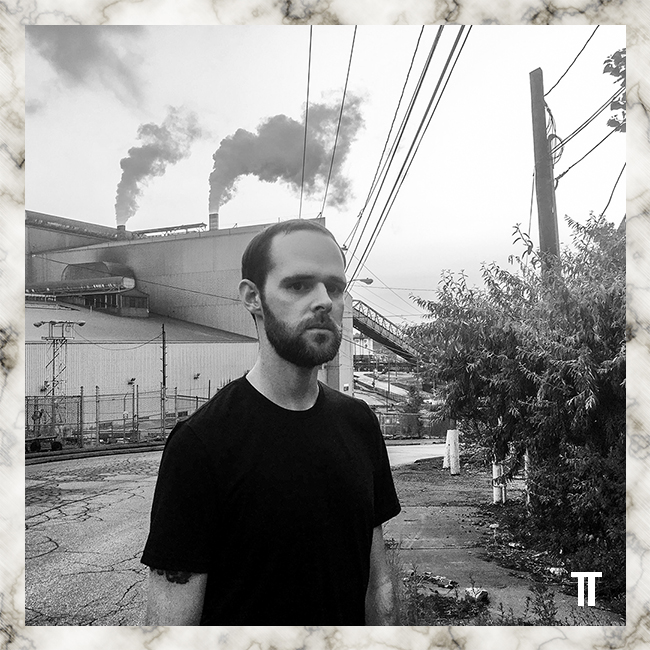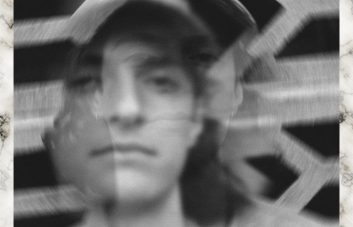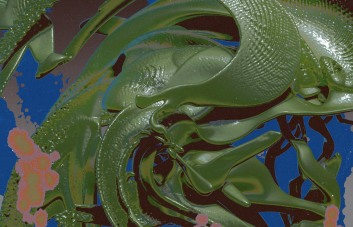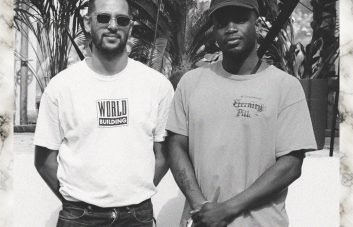Direct from the Midwest our latest Truancy Volume arrives courtesy of synth journeyman Steve Hauschildt. While prolific as a member of drone supergroup Emeralds – Discogs has the count at almost fifty releases in six years, his solo records have emerged at a slower pace. That extra time certainly wasn’t wasted. Wrapped in ideas from Greek myth or surrealist landscapes, each plunges into a world and pulls us with it. Strands, his latest LP out this week on Kranky, continues that trend. It’s an infinitely rendered landscape to explore, listen, and get lost in. In addition to the mix, a snapshot of current favourites, Steve was kind enough to dive into a few questions, touching on everything from Pythagoras, to his home base of Cleveland, to Star Trek: Voyager.
Your last few albums have centered around a theme, is that your starting point? Or does it emerge in tandem with the work? How did the ideas behind Strands come together? “While there is a thematic element to most of my albums I would say that it never really functions as the starting point. The music is central and the cohesion of ideas and themes emerges later on because I’m taking in and processing information throughout the months and years that it takes to make an album. So whether I’m listening to a bunch of Carl Sagan lectures or watching Ozu’s Late Spring in the theatre or watching Star Trek: Voyager continuously at home, that influence is probably going seep out eventually in some way or another. I don’t try explicitly integrate my influences into my work like some of my peers but that doesn’t mean I’m not deeply affected by everything that I choose to surround myself with. I don’t feel an impulse to sample or appropriate others’ work though. it seems like provenance dies a little with each passing year which is pretty alarming but maybe this is just symptomatic of social media. That’s not to say that I don’t embed references to other works through my titles- I certainly do that- but there’s been a kind of cultural feedback loop going on and it’s actually refreshing to just not even engage with it and to instead make something that seeks to be outside of that universe entirely. The main idea behind Strands came after the album was completed when I was working on the visual art for the cover. I was using a rope generator with 3D modelling software and adjusting all of these parameters very meticulously. It was through this seemingly mundane, unrelated process that I came to unify some of the musical compositional processes conceptually. The relation of the album to the Cuyahoga River and my hometown of Cleveland was something that I had been thinking about for quite some time but never really expressed until now. To an extent all of my albums have been influenced by my surroundings here. The only way I can describe it is that it’s like living inside of Antonioni’s Red Desert.”
How do you approach composition? Did you have similar methodologies when collaborating with the other members of Emeralds? “There’s a procedural and automated component to some of the music which is very critical to the final composition. I use MIDI to control everything in my studio and have a lot of plugins mapped to a main controller but every song utilises different chains and effects. Even then a lot of things change during the mixing process. With this particular album, Rafael Anton Irisarri and I spent considerable time painstakingly redoing and improving a lot of the effects chains that I set up at home. But it was worth it because it opened the album up to a lot of colours that I can’t really create with my equipment. It’s hard to describe, but basically his studio has a wider vocabulary with which to work than my home studio. In my opinion there’s more complexity to the music on this album than anything I’ve done to this point. I think some the textural stuff might get buried or lost because I use tonality and chord progressions but it’s still there lurking underneath the songs.
Other than the last Emeralds album which was the only one done in a proper studio, was a totally different feel and process. But we were definitely champions of home recording for many years and I carry that with me. Actually during the first few years of Emeralds we never had any idea what tuning we were in at any given time. This resulted in some weird atonality and there was a certain charm to the naivety of that music I think (with regards to our ability to improvise and record as well). I’ve taught myself too much about music since then to make all of those beautiful mistakes again. But I think from Solar Bridge onwards we had much more control and direction over our music and there were certainly some methodologies then that are still relevant today. I think my collaboration with John and Mark was the most impactful thing for me personally in my musical life and I’m sure they both feel the same about the project. The thing about Emeralds that is impossible to replicate was when our music would structurally fall apart and come back together again. The anti-grid approach was really only possible because we had played together for so long I think.”
You’ve mentioned the Cuyahoga river inspired some aspects of Strands. Are there any other elements of Cleveland’s post-industrial landscape that have made their way into your work? “There’s a lot of these rusted-out bridges that are scattered along the river in various places. They kind of haunt the landscape near the downtown area and I’ve been infatuated with them since I was younger as I grew up in the suburbs which was isolated from a lot of this imagery. In my early 20’s I would go down and photograph them with my friend. The city is laced with post-industrial detritus and the patina that covers of all of these structures has definitely inspired me. Even though some of them have closed down since their heyday, the steel plants dominate much of the landscape and many are still operational in the Industrial Valley. Driving on the many highways through the city you’re pretty much surrounded by flames and smoke. In Cleveland there is also this glossy, fake layer of newer enterprises that distracts people from the reality of its de-industrial nature. So when you’re walking along certain parts of the Flats it just has this appearance of supplanted culture which is disconcerting to me. I’m more into the non-stratified areas of the city and viewing them as an outside observer.”
The art of surrealist painters like Kay Sage informed your last record Where All is Fled. Is there any artist you’re currently transfixed with? “I just downloaded and having been poring over this PDF of a book by the filmmaker John Whitney called Digital Harmony. I’ve been into his work for a decade or so but it’s been pretty enlightening to actually break down some of his processes and see where he’s coming from from a creative standpoint finally. I’ve also found that he was pretty into the work of Pythagoras which makes a lot of sense considering the geometrical aspect of his films. So now I’ve been reading articles and watching documentaries about Pythagoras since he actually had quite a mysterious life and most that we know about him is through indirect writings by Plato and others. To be honest my last album was more influenced by the pre-Socratic idea of flux pioneered by Heraclitus more than anything but it’s still pretty crazy that Pythagorean thought had such a huge influence on Plato’s concept of forms among other invaluable philosophical insights. I also find it quite funny that Pythagorean followers couldn’t eat beans. There’s a lot of speculation as to why- it could have been due to the prevalence of favism or simply that their belief in reincarnation restricted them from doing so because of the symbolism of beans representing rebirth or something to that effect.”
Cleveland incubated an active experimental music scene for years, is it still going strong? Are there any emerging artists you dig? “Yeah, totally. I mean, a lot of people have moved on or moved to another city altogether but there’s still a base of people here holding things down. It’s good to have a record store like the Bent Crayon here because that keeps people here into actual, good music. There’s people like James Donadio (Prostitutes) and Machine Listener who are putting out good stuff for example. I really think more musicians should move here since the cost of living is so low and it affords you all of the conveniences of a major urban city. It costs about three times less to live in Cleveland than Portland or NYC for example.”
Given that many of your releases have a concept at their core, is there one behind this mix? “Not really other than the fact that I wanted it to be predominantly stuff from this year that I liked. I have no way of gauging this but I probably listen to like 90% older weird records that I find or come across and the rest is new stuff by people I respect or friends. So with this mix I wasn’t so much trying to flex my ability to uncover hidden gems or anything so it’s more of the contemporary stuff that I think will stand the test of time. This was another great year for music!”
Tracklist:
Pete Namlook – Ancient Beauty
Les Points – Sowaswotdochjede
ARIISK – TKN IOb
Architectural – Plastic Dreams
NGLY – Strange Expression
Pita – Line Angel
Mirage Man – 6AM
Jochem Paap – Flm
Eluvium – Rorschach Pavan
H Takahashi – Absorption
Function – Voiceprint
Convextion – Flyby
Rrose – Emboli
Schleifen – 8
Brett Naucke – Dying Season 93′
Okihide – Blue




